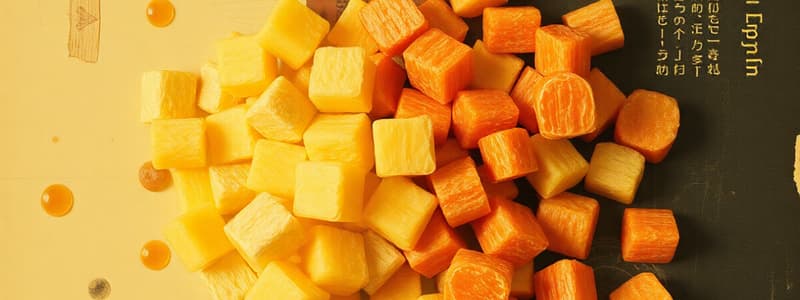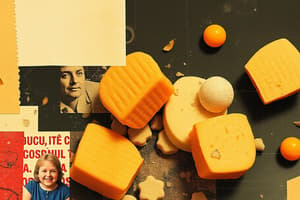Podcast
Questions and Answers
Which of the following is a type of monosaccharide?
Which of the following is a type of monosaccharide?
- Galactose (correct)
- Lactose
- Starch
- Sucrose
Fructose is commonly found in honey, fruits, and root vegetables.
Fructose is commonly found in honey, fruits, and root vegetables.
True (A)
What is the chemical formula ratio of carbon, hydrogen, and oxygen in carbohydrates?
What is the chemical formula ratio of carbon, hydrogen, and oxygen in carbohydrates?
1:2:1
Glucose, known as the 'brain sugar', plays an important role in _____ development.
Glucose, known as the 'brain sugar', plays an important role in _____ development.
Which disaccharide is composed of glucose and fructose?
Which disaccharide is composed of glucose and fructose?
Complex carbohydrates are also referred to as simple sugars.
Complex carbohydrates are also referred to as simple sugars.
Name one natural source of galactose.
Name one natural source of galactose.
Match the following monosaccharides with their common sources:
Match the following monosaccharides with their common sources:
What are the components of triglycerides?
What are the components of triglycerides?
Polysaccharides are formed by linking many monosaccharides together.
Polysaccharides are formed by linking many monosaccharides together.
What is the simplest form of carbohydrate?
What is the simplest form of carbohydrate?
Glucose + Glucose = ______
Glucose + Glucose = ______
Which of the following is considered a homopolysaccharide?
Which of the following is considered a homopolysaccharide?
Match the carbohydrate type with its description:
Match the carbohydrate type with its description:
Name one source of maltose found in natural foods.
Name one source of maltose found in natural foods.
Triglycerides are solid at room temperature and are used by plants for long-term energy storage.
Triglycerides are solid at room temperature and are used by plants for long-term energy storage.
What is the primary function of lipids?
What is the primary function of lipids?
Cis double bonds in unsaturated fatty acids create a straight chain structure.
Cis double bonds in unsaturated fatty acids create a straight chain structure.
What are the components of phospholipids?
What are the components of phospholipids?
Cholesterol is a precursor for the synthesis of hormones such as _____ and _____
Cholesterol is a precursor for the synthesis of hormones such as _____ and _____
Match the following lipid types with their descriptions:
Match the following lipid types with their descriptions:
Which statement correctly describes the effect of unsaturated fatty acids on membrane fluidity?
Which statement correctly describes the effect of unsaturated fatty acids on membrane fluidity?
Integral membrane proteins are loosely attached to the exterior of the membrane.
Integral membrane proteins are loosely attached to the exterior of the membrane.
The hydrophilic part of a phospholipid is known as the _____ head.
The hydrophilic part of a phospholipid is known as the _____ head.
What is the principal component of carnauba wax?
What is the principal component of carnauba wax?
Amino acids can only be found in animals.
Amino acids can only be found in animals.
What are the two functional groups present in the general structure of amino acids?
What are the two functional groups present in the general structure of amino acids?
The arrangement in space of the atoms in the peptide backbone is called the __________ structure.
The arrangement in space of the atoms in the peptide backbone is called the __________ structure.
Match the amino acid properties with their descriptions:
Match the amino acid properties with their descriptions:
Which amino acid is replaced by valine in sickle-cell anemia?
Which amino acid is replaced by valine in sickle-cell anemia?
Sphingolipids contain glycerol as part of their structure.
Sphingolipids contain glycerol as part of their structure.
In amino acids, what does the 'R' group determine?
In amino acids, what does the 'R' group determine?
Which of the following nitrogenous bases is classified as a pyrimidine?
Which of the following nitrogenous bases is classified as a pyrimidine?
Hemoglobin consists of three polypeptide chains.
Hemoglobin consists of three polypeptide chains.
What is a distinguishing feature of proteins compared to polypeptides?
What is a distinguishing feature of proteins compared to polypeptides?
Fibrous proteins have an overall shape that is spherical.
Fibrous proteins have an overall shape that is spherical.
What type of sugar is found in DNA?
What type of sugar is found in DNA?
RNA contains the nitrogenous base _____ instead of thymine.
RNA contains the nitrogenous base _____ instead of thymine.
What type of bond is a major determinant of secondary structure in proteins?
What type of bond is a major determinant of secondary structure in proteins?
Match the following terms with their correct definitions:
Match the following terms with their correct definitions:
The two types of nucleic acids are _____ and _____.
The two types of nucleic acids are _____ and _____.
Which component is part of the backbone of DNA?
Which component is part of the backbone of DNA?
Match the following proteins with their characteristics:
Match the following proteins with their characteristics:
RNA is predominantly involved in DNA replication.
RNA is predominantly involved in DNA replication.
Which of the following best describes hydrophobic interactions in proteins?
Which of the following best describes hydrophobic interactions in proteins?
What is the primary function of hemoglobin?
What is the primary function of hemoglobin?
Electrostatic attraction occurs between like-charged groups on the surface of a molecule.
Electrostatic attraction occurs between like-charged groups on the surface of a molecule.
What role does DNA play in a cell?
What role does DNA play in a cell?
Flashcards
Monosaccharides
Monosaccharides
Simple sugars; building blocks of all carbohydrates; compounds containing a single carbonyl group and two or more hydroxyl groups.
Glucose
Glucose
A monosaccharide, important energy source, nourishes the brain.
Fructose
Fructose
A monosaccharide, commonly found in fruits and some vegetables.
Galactose
Galactose
Signup and view all the flashcards
Disaccharide
Disaccharide
Signup and view all the flashcards
Lactose
Lactose
Signup and view all the flashcards
Sucrose
Sucrose
Signup and view all the flashcards
Carbohydrates
Carbohydrates
Signup and view all the flashcards
Oligosaccharides
Oligosaccharides
Signup and view all the flashcards
Homopolysaccharide
Homopolysaccharide
Signup and view all the flashcards
Heteropolysaccharide
Heteropolysaccharide
Signup and view all the flashcards
Polymer
Polymer
Signup and view all the flashcards
Triglycerides
Triglycerides
Signup and view all the flashcards
Unsaturated Fatty Acids
Unsaturated Fatty Acids
Signup and view all the flashcards
Cis Configuration
Cis Configuration
Signup and view all the flashcards
Trans Configuration
Trans Configuration
Signup and view all the flashcards
Phospholipid Structure
Phospholipid Structure
Signup and view all the flashcards
Biological Membrane Fluidity
Biological Membrane Fluidity
Signup and view all the flashcards
Steroid Structure
Steroid Structure
Signup and view all the flashcards
Cholesterol function
Cholesterol function
Signup and view all the flashcards
Integral Membrane Protein
Integral Membrane Protein
Signup and view all the flashcards
What is a prosthetic group?
What is a prosthetic group?
Signup and view all the flashcards
What is Heme?
What is Heme?
Signup and view all the flashcards
What is a subunit?
What is a subunit?
Signup and view all the flashcards
What is Quaternary Structure?
What is Quaternary Structure?
Signup and view all the flashcards
What are non-covalent interactions?
What are non-covalent interactions?
Signup and view all the flashcards
What is a tetramer?
What is a tetramer?
Signup and view all the flashcards
What is Hemoglobin?
What is Hemoglobin?
Signup and view all the flashcards
What is a nitrogenous base?
What is a nitrogenous base?
Signup and view all the flashcards
Polypeptide
Polypeptide
Signup and view all the flashcards
Protein
Protein
Signup and view all the flashcards
Primary Structure
Primary Structure
Signup and view all the flashcards
Secondary Structure
Secondary Structure
Signup and view all the flashcards
Tertiary Structure
Tertiary Structure
Signup and view all the flashcards
Quaternary Structure
Quaternary Structure
Signup and view all the flashcards
Fibrous Protein
Fibrous Protein
Signup and view all the flashcards
Globular Protein
Globular Protein
Signup and view all the flashcards
Amino Acid Structure
Amino Acid Structure
Signup and view all the flashcards
Chirality in Amino Acids
Chirality in Amino Acids
Signup and view all the flashcards
What determines an amino acid's identity?
What determines an amino acid's identity?
Signup and view all the flashcards
Sphingolipids
Sphingolipids
Signup and view all the flashcards
Carnauba Wax
Carnauba Wax
Signup and view all the flashcards
Primary Structure of Proteins
Primary Structure of Proteins
Signup and view all the flashcards
Sickle-Cell Anemia
Sickle-Cell Anemia
Signup and view all the flashcards
Secondary Structure of Proteins
Secondary Structure of Proteins
Signup and view all the flashcards
Study Notes
Carbohydrates
- Carbohydrates are macromolecules composed of carbon, hydrogen, and oxygen. They include simple sugars (small ring structures) and complex carbohydrates (long chains).
- Also known as sugars.
- The ratio of elements in carbohydrates is 1:2:1 (carbon:hydrogen:oxygen).
- Simple sugars are important in diets; examples include glucose, fructose, and galactose.
Types of Monosaccharides
- Glucose: A primary energy source; found in honey, fruits, and root vegetables.
- Fructose: Sweet taste; found in fruits and honey.
- Galactose: "Brain sugar"; supports brain development in infants; part of lactose (milk sugar).
Types of Disaccharides
- Lactose: Glucose + Galactose; found in milk
- Sucrose: Glucose + Fructose; "table sugar"; found in fruits and vegetables.
- Maltose: Glucose + Glucose; found naturally in some foods (e.g. cooked sweet potatoes, pears).
Polysaccharides
- Formed by linking many monosaccharides.
- Examples include glycogen (energy storage in animals), starch (plant energy storage), and cellulose (structural component in plants).
Lipids
-
Lipids are hydrophobic biomolecules.
-
They play a key role in energy storage in living organisms.
-
Categories of lipids include triglycerides, phospholipids, steroids, and waxes.
- Triglycerides: Fats (solid at room temp) and oils (liquid at room temp). Used for long-term energy storage. Composed of glycerol and fatty acids.
- Phospholipids: Similar to triglycerides; contain a hydrophilic head and hydrophobic tails; critical in cell membranes.
- Steroids: Composed of four fused carbon rings; examples include cholesterol, which helps stabilize cell membranes.
- Waxes: Complex mixtures of esters; act as protective coatings in plants and animals.
Nucleic Acids
- The genetic blueprint of cells. Contains instructions for cell functions.
- Two main types: DNA and RNA.
- DNA: Double helix structure; composed of deoxyribose sugar, phosphate, and nitrogenous bases (adenine, guanine, cytosine, and thymine).
- RNA: Single-stranded structure; composed of ribose sugar, phosphate, and nitrogenous bases (adenine, guanine, cytosine, and uracil); involved in protein synthesis. -Types: mRNA, tRNA, rRNA, microRNA
Protein
- Proteins are complex molecules composed of amino acids.
- Critical for various cellular functions.
- 4 Levels of structural organization:
- Primary: The sequence of amino acids in a polypeptide chain.
- Secondary: Localized folding or twisting of polypeptide chain (e.g. alpha helix, beta pleated sheet).
- Tertiary: Overall 3D structure of the protein; interactions of side chains influencing folds.
- Quaternary: Structure of proteins with more than one polypeptide chain; how multiple chains interact.
Studying That Suits You
Use AI to generate personalized quizzes and flashcards to suit your learning preferences.



